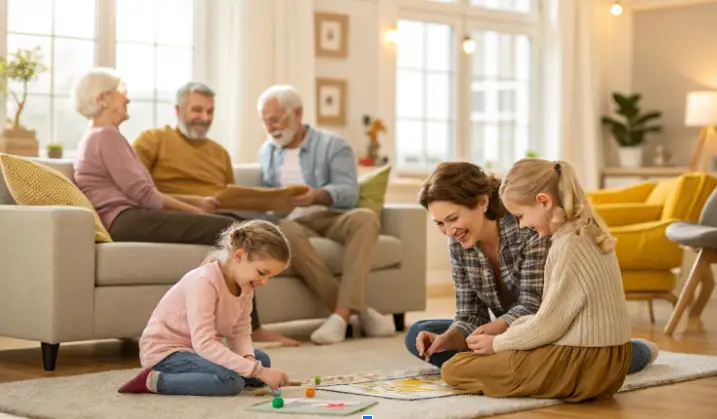
Inclusive Home Design Ideas for All Abilities
Designing Homes for Everyone: How Inclusive Design Creates Safer, Smarter, and More Comfortable Living Spaces
Universal design is a way to build homes that truly work for everyone. Inclusive home design ensures comfort, safety, and independence without sacrificing style. Whether you’re renovating for accessibility or planning your forever home, the right choices today can mean a better quality of life tomorrow.
In this guide, we’ll break down the key features of inclusive design — like step-free entries, adjustable worktops, smart home tech, and accessible outdoor areas — and show how thoughtful planning can transform a house into a welcoming, functional space for all ages and abilities.
Key Takeaways
| Feature | Why It Matters | Examples |
|---|---|---|
| Universal Design | Makes homes accessible for everyone | Low-threshold entrances, adjustable-height worktops |
| Durable Fixtures | Withstands frequent use and equipment | Reinforced cabinetry, hard-wearing materials |
| Outdoor Access | Extends independence and social connection | Ramps, wide paths, raised planters |
| Smart Home Tech | Boosts safety and ease of use | Voice-controlled lighting, automated doors |
| Ageing in Place | Allows older people to stay in familiar homes | Lever handles, improved lighting, non-slip floors |
Designing Homes That Work for Everyone
Inclusive home design means doing more than the minimum to meet building regulations. It’s about creating living spaces that work well for disabled people, older people, and anyone who wants to future-proof their home.
That means building for comfort, ease, and dignity. Whether you’re adapting an existing space or designing from scratch, it’s about meeting real needs with practical solutions — without compromising style or personal taste.
What Universal Design Really Means
Universal design goes beyond accessibility checklists. It’s a design philosophy that ensures everyone can use a space without needing changes or special permission.
Core features of universal design include:
- Equitable use – spaces that work for everyone, regardless of mobility, vision, or dexterity
- Flexibility – layouts that adjust easily as needs change
- Low effort – fixtures that are easy to reach, open, and use
- Durability – materials and finishes that hold up under daily use, including wheelchairs and other equipment
Think:
- Reinforced cupboards and shelving that won’t buckle
- Worktops and sinks at varying heights
- Floors that are smooth enough for wheels but textured enough to prevent slips
Site preparation is just as important. Grading a garden for a level entrance or installing a wide, step-free driveway might mean using heavy-duty machinery — but it lays the groundwork for genuine independence at home.
The right tools make all the difference when preparing sites for inclusive design. Case heavy equipment and aftermarket parts provide the power and precision needed to create level entryways, widened driveways, and smooth terrain transitions crucial for wheelchair users and others with mobility challenges. This foundation work, though often invisible in the finished home, is essential for true accessibility.
Making the Outdoors Accessible — and Beautiful
An inclusive home doesn’t stop at the front door. Outdoor areas should be just as inviting, functional, and safe.
Here’s how to do it:
Functional Elegance
A stylish garden can still be practical. For example:
- Wrought iron fencing offers privacy, durability, and a clean look (see more on this below!)
- Gazebos and pergolas create accessible shade and structure without blocking movement
- Traditional finishes like stone paths or brick planters can be paired with modern access features
Why Wrought Iron Fencing Works Well in Accessible Gardens

Decorative wrought iron fencing is a smart choice for accessible outdoor spaces. It doesn’t just help with security — it also marks out space clearly and can look great with any home style.
You can choose from different designs to match your taste, whether modern or traditional. It’s also very strong and long-lasting, even in bad weather. Over time, that makes it a reliable and cost-effective option.
Because it works well with natural materials like stone, wood, or plants, wrought iron helps bring together function and style — something that’s important in any inclusive garden.
Must-Have Outdoor Features

- Gentle slopes and ramps: Replace stairs with smooth transitions
- Non-slip paving: Brushed concrete or rubberised materials offer grip
- Wide walkways: Make room for wheelchairs, pushchairs, or walking aids
- Raised garden beds: Allow seated or standing gardening without strain
- Outdoor lighting: Solar-powered lights add safety and visibility at night
Gardens should never look clinical. It’s about making them usable by everyone, no matter their age or mobility.
Adapting Homes for Ageing in Place

A large number of disabled people are older people who want to remain in their own homes. Ageing in place doesn’t mean care homes aren’t sometimes the best option — it’s about having the choice to stay in your own home, with the right support, comfort, and control, if you want to.
FAQ What is ‘Ageing in Place’
Ageing in place means staying in your own home safely and comfortably as you get older, rather than moving into a care home or supported housing.
To make this possible, your home might need a few changes — like adding grab rails, better lighting, or easy-to-use taps and switches. Some people also use smart tech to control lights, heating, or door locks with their voice or a phone.
The goal is to help people stay independent, keep their routines, and live in a space that feels familiar and safe.
Here are some of the most effective ways to support ageing in place:
Small Changes, Big Impact
- Adjustable-height counters and cupboards to support standing or seated use
- Smart home features like voice-controlled heating, curtains, security and lighting. That means no more struggling with hard-to-reach switches or trying to remember lots of different settings.
- Easy-grip handles and taps that reduce joint strain
- Improved lighting to prevent falls and aid visibility
- Contrasting colours around doors, switches, and stairs for those with sight loss
None of these changes need to feel clinical or out of place. In fact, many smart home features are now integrated into stylish, modern designs. What used to be seen as luxury is now a practical way to stay safe and independent, especially if your mobility or eyesight changes over time.
Why It Matters
Adapting a home can:
- Support independence and daily decision-making
- Reduce accidents and hospital visits
- Avoid the cost and disruption of moving to residential care
A well-designed home can age alongside its residents — offering comfort, privacy, and control throughout life.
Thoughtful Design for All Needs
Inclusive design isn’t about ticking boxes — it’s about planning for real people. That includes:
- Structural Access: Wide doorways, strong flooring, step-free entries
- Safety Features: Grab rails, lighting, textured surfaces
- Outdoor Access: Level paths, raised planters, durable furniture
- Smart Tech: Automated lights, temperature, and doors
- Sensory Awareness: Vibration-friendly floors for Deaf or DeafBlind residents
Here’s your rewritten paragraph in Disability Horizons style — clear, practical, and respectful:
Why Vibration-Friendly Flooring Matters
For Deaf and DeafBlind people, certain types of flooring can help them pick up vibrations from movement around the home. Solid surfaces like wood or concrete can make it easier to sense when someone enters a room or moves nearby.
This can improve spatial awareness and communication — especially in shared spaces. It’s a simple design choice, but it can make a big difference to how connected someone feels to their surroundings.
These elements are just the start. Inclusive design encourages us to think holistically — not just about who lives in a home now, but who may live there in the future.
Final Thoughts: A Home That Welcomes Everyone
Inclusive home design is about more than ramps and rails. It’s helps to make sure everyone feels comfortable, confident, and truly at home.
With thoughtful planning, adaptable technology, and a bit of creativity, any space can become more inclusive. It’s a win-win — for disabled people, for older people, for families, and for anyone who wants a home that works better for everyone.
Article by Chase Webb
Chase Webb is a Portland-based writer who loves turning big ideas into simple, engaging stories. He’s passionate about storytelling and the magic of great writing. When he’s not writing, he’s knee-deep in fiction novels with worlds too wild to exist.